Burner types
There are five basic types of fuel burning home heating appliances: ultra-low emission burners, low emission burners, gas and diesel burners, older-style burners and open fires. On this page there is information about each type and how our home heating measures apply to them.
Older technology is being phased out over time and financial assistance is available, where genuine need exists, to enable households to upgrade their home heating systems.
Ultra-low emission burners
Ultra-low emission burners are any solid fuel burners, including pellet burners, that achieve a stringent real-life emission standard – they are the cleanest solid fuel burners and are allowed anywhere with no age restriction.
Low emission burners
Low emission burners are the most common burners in Canterbury and have been around since the early 2000s. These burners burn wood or pellets and will generally have only one air flow control and will not be able to be banked down overnight. You can use these burners in most areas, but in some Clean Air Zones they are being phased out. Fitting an approved secondary emission reduction device to a National Environmental Standard compliant low emission burner may extend its use.
Gas and diesel burners
Gas and diesel burners are generally boilers or gas fires that run on LPG or diesel. So long as they have a rated output of 40kW or less, they are allowed to be used anywhere, with no age restriction.
Older-style burners
Older-style burners are generally only common outside of Christchurch, Kaiapoi, Rangiora and Ashburton. They may have two air flow controls, a grate and an ash pan and may be multi-fuel burners. They can be banked down overnight. These burners are being phased out in all Clean Air Zones and in Christchurch they can no longer be used. Fitting an approved secondary emission reduction device to a National Environmental Standard compliant older-style burner may extend its use.
Open fires
Open fires are any fire places that are not enclosed and in which air flow cannot be controlled. These burners are being phased out in all Clean Air Zones and in Rangiora, Kaiapoi, Christchurch, Ashburton and Timaru they can no longer be used.
Secondary emission reduction devices
Secondary emission reduction devices allow you to use your National Environment Standard compliant burner past the usual 15-year limit.
Approved secondary emission reduction devices
The most recently approved device, the OekoTube, is an electrostatic precipitation device, integrated into the flue system to reduce particulate discharges to the equivalent of an ultra-low emission wood burner. The device can be installed on a National Environment Standard compliant burner with an emission factor of 1.5g/kg or less. The burner and emission-reduction device must be installed, operated and maintained in accordance with the manufacturer’s instructions and the conditions of the resource consent (CRC212092).

